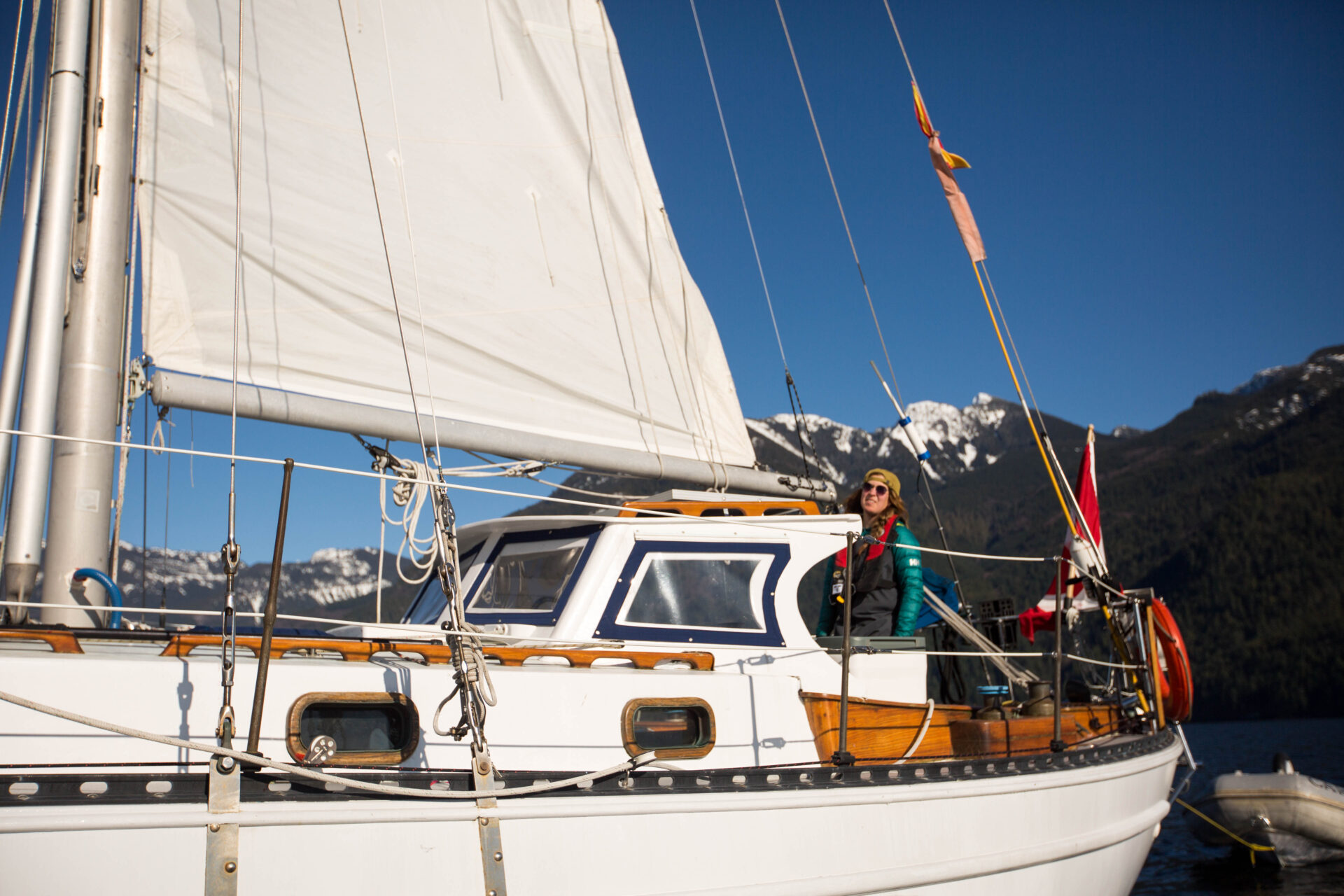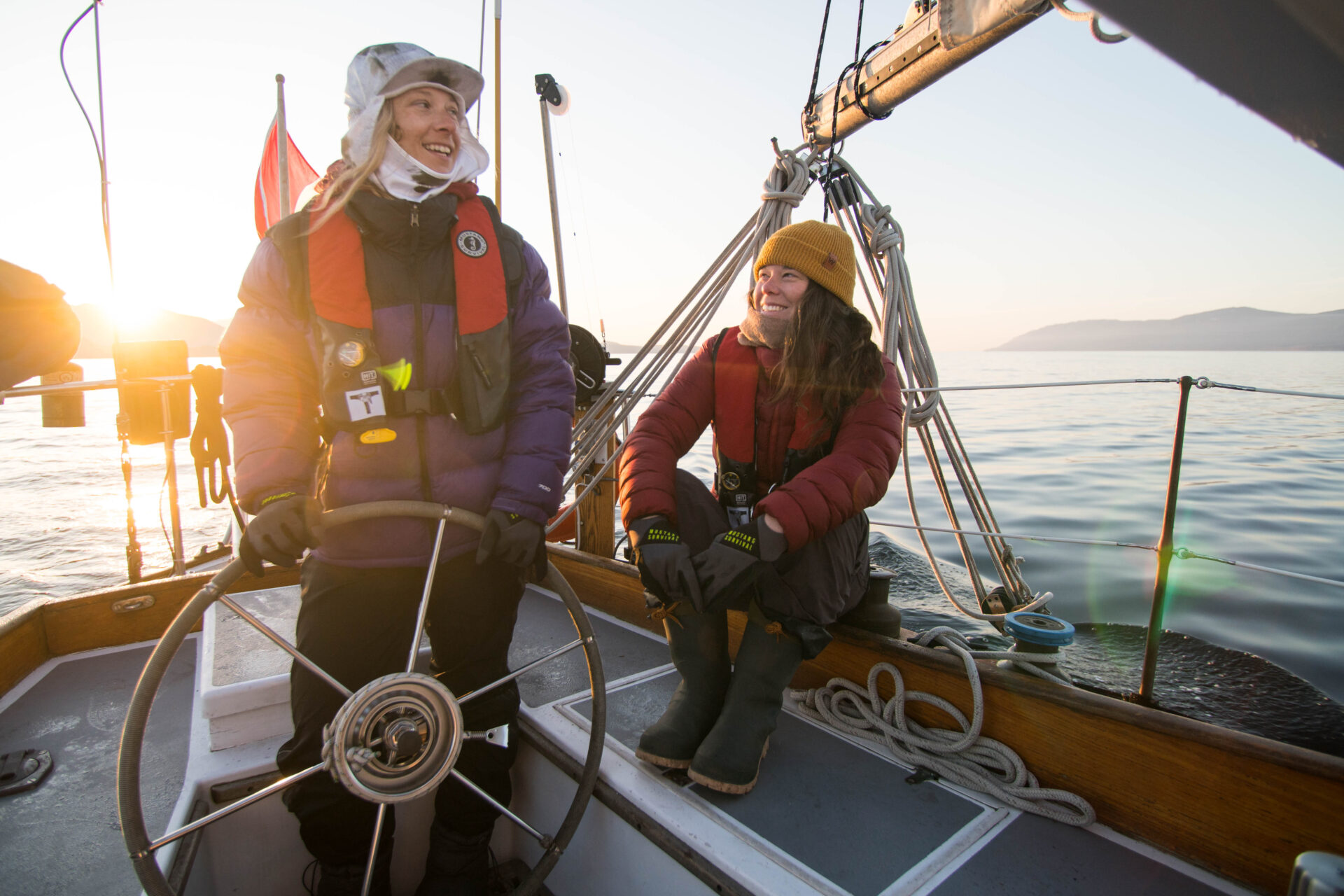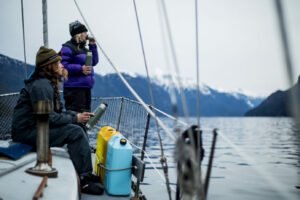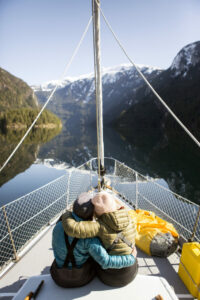It started as a dream to combine sailing and snowboarding. I spent hours researching sailing/skiing expeditions in Norway but I just couldn’t justify spending the money to fly across the world when I have my own boat. Plus, British Columbia’s geography seems so similar to those Scandinavian fjords, so shouldn’t it be possible to combine the two activities here in our own backyard?
Maybe I was overconfident in my ability to pull this off, or perhaps just a little naive. Regardless, I couldn’t get this idea out of my head and soon this multi-sport concept consumed me. I found four other women to join me, all snowboarders and all just as crazy as me. We weren’t best friends and one I hadn’t even met before, but that changed quickly after being in close confinement for seven days together on my 35-foot sailboat—a 1976 Jason 35. We all brought different skills to the expedition, but ultimately, it was our love for snow that shaped our commonalities. Abby Cooper brought her expertise as snow-nerd and photographer, Gillian Andrewshenko enlightened us with her ability to speak the truth, Caley Vanular graced us with her calm demeanor, Kate Ediger brought her big heart, and then there was me, who somehow convinced four others to trust me to guide them up the winding fjords of British Columbia’s intricate coastline.
The northwest wind pushed us south wing-on-wing from Campbell River across the Strait of Georgia. Our end goal was Princess Louisa Inlet. The mission didn’t seem to matter the moment we saw the orca’s sleek dorsal fin cut through the water in front of us. I turned the engine off and we floated beside the pod, feeling honoured to share the water with such powerful creatures. After a leisurely sail, we eventually made it to our anchorage at Goliath Bay where I taught my green crewmember, Gill, how to lower the anchor. We holed up for the night and watched the sparkle of the stars above us and the phosphorescence below us.
Darkness surrounded us in all directions as we left in the morning to try and reach Malibu Rapids for slack tide at noon. The cloud cover slowly dissipated as we neared Princess Louisa. The sun’s strong rays hit us and we quickly shed layers; the Sechelt (shíshálh) Nation’s original name Suivoolot (sunny and warm), seemed like a more fitting name. Abby pulled out the binoculars and was analyzing the terrain for signs of recent avalanches. We switched Navionics over to topo mode so we could compare what we were seeing to where we were in Princess Royal Channel. The hundreds of feet under my keel felt comforting as we zig-zagged up the channel; the mountains seemed to grow taller. As we rounded each corner, we became increasingly distracted by the new peaks that revealed themselves, luring us in with their promise of sweet turns.
I nosed Spray into Malibu Rapids just before noon, the currents were minimal and the tide was high. We were almost at our destination and anxious to start planning the next stage of our adventure. I could see why Captain Vancouver bypassed this entrance when searching for the Northwest Passage; I started out cautiously. With growing confidence, I pushed the throttle forward to give myself more steerage as I approached the next corner. I glanced down at Navionics and noticed the chart was still in black and white topo mode, but did not want to take my eyes away from the entrance ahead of me to switch it back. Moments later the boat lurched in a way that I had only imagined in my nightmares. The sudden movement threw Kate to the deck and the others grabbed on to the nearest shroud beside them. Instantly, I realized my error and threw back the throttle, yet the rock didn’t seem to pity my naivete. Spray bounced over the mass three times before twisting to one side and freeing herself. I glanced at the chart again and made the decision to keep moving forward, as I was almost at the actual passage. I thought back to my decision on purchasing a boat with an encapsulated keel and knew that even if I never took Spray offshore, the extra cost was worth every penny. My steerage seemed fine and I quickly instructed my crew on how to check the bilge. As the depth reading under my keel grew, a wave of relief flooded over me.
We tied up at the dock at the head of Princess Louisa and I collapsed on the dock in need of a stiff drink. I inspected the hull with my GoPro and was satisfied to leave repairs for another day. It was only then that I was able to take a breath and look up. The surrounding snow-covered peaks reached into the sky as if born by the ocean’s depths. With our gear strewn all around us we packed our bags and switched gears to mountain mode. A deep growler let loose somewhere above us and we knew it was the mountains warning us of what they are capable of.
The skills that my crew lacked on board the boat, they made up for by their enthusiasm to learn and by their wealth of knowledge in the mountains. It was my turn to step back as captain and let the others lead. Abby charged forward and we followed eagerly. It didn’t take long to realize that the hardest part of this uphill climb was route finding through the downed trees and an ironically low snow line. Our splitboards (a snowboard that splits down the middle making two skis with skins for climbing and touring) were strapped to our loaded packs as we crawled under and over trees plugging our way up. The trail we were following is commonly known to cruisers as the Trappers Cabin trail. I had last been here when I was eight years old on my family’s 28-foot Tollycraft. I don’t remember much from that trip, but I recall making it to the cabin. Easy right? As we postholed through the slushy snow trying to find the next little piece of flagging tape that led us forward, things slowed down substantially. There was enough snow to make the trail slow and slippery, but not enough to put our splitboards on. We finally made it past the remnants of the cabin and the partially frozen waterfall that marked our one third distance. It was already 14:00 and we knew that we had to make a decision based on all the factors that were stacking up against us.
It’s not an easy conversation to have, but egos must be put aside and the safety of the group must be the top priority. It was later in the day than we were hoping, the snowline was lower than expected, and there were limited resources for help. I swallowed my pride and piped up, agreeing that this was not our time. After months of planning, was this really how we were going to leave it? It took us four hours to descend as we carried our 60-pound bags and snowboards back down to sea level. Acceptance slowly surged over the group as we all fought to keep our spirits high.
Spray welcomed our tired bodies home as the sun set over the pristine inlet. I lit the diesel stove and we piled back aboard. We slid our snowboards back into the hold and it didn’t take long before the group was playing a game of dice and starting to plan next year’s attempt.
So, maybe British Columbia’s coast isn’t exactly the same as Norway’s. But I’m still convinced our mission of combining snow and sail is possible. Perhaps it just takes a little more effort along the way to really earn those turns? I just hope that next year there are no rocks in the way.




